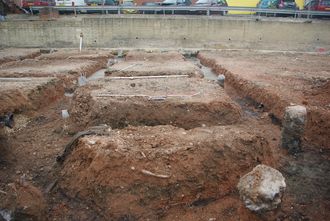Acorn Business Centre, 1-16 Empress Road, Southampton. Archaeological Watching Brief and Geoarchaeological Evaluation (SOU1678)
Andy Russel, Tobias Riley, Rob Scaife, Anne Davies, Nigel Cameron, Virgil Yendell, 2019. https://doi.org/10.5284/1056103. How to cite using this DOI
Data copyright © Museum of London Archaeology, Southampton City Council Archaeology Unit unless otherwise stated
This work is licensed under the ADS Terms of Use and Access.
Primary contact
Southampton City Council Archaeology Unit
18 Melbourne Street
Southampton
SO14 5FB
Tel: 023 8063 4906
Resource identifiers
- ADS Collection: 3483
- DOI:https://doi.org/10.5284/1056103
- How to cite using this DOI
Introduction

The Archaeology Unit of Southampton City Council carried out archaeological investigations at the Acorn Business Centre at 1-16 Empress Road, Southampton in 2014 and 2015. The purpose of the fieldwork was to record the deposits that survived at the site and to take cored samples of the prehistoric peat for analysis and dating. The drilling of piles and the excavation of ground beam slots were observed, with Museum of London Archaeology taking a window sample through the below-ground deposits.
The lowest deposit observed in the piling was the London Clay. This was overlain from -5.27m OD by sands and gravels of the Whitecliff Sand Member. These were cut by the valley of the Itchen in the Pleistocene period. The earliest surviving river valley deposits were sand and silt that included pond weed remains indicating standing fresh water. This was followed by increased organic content suggesting vegetation encroachment leading to peat formation. The peat was a mix of sedge and alder with alder becoming more prevalent towards the top, after which tidal inundation began to affect the area. The base of the peat, which was at c.-4m OD, was radiocarbon dated to the early Mesolithic period (10225 to 10165 cal BP) and the top of the peat, which was at c.-1.55m OD, was radiocarbon dated to the mid-Mesolithic period (7715 to 7620 cal BP). This would give a total rise in relative sea level of 2.45m over approximately 2250 years being on average just over 1mm a year. The changes in lithology, vegetation and hydrology seen in the deposits undoubtedly resulted from positive relative sea-level change, well documented for the Solent. The prehistoric deposits were overlain by disturbed tidal flat deposits and 19th century made ground.
The base of the peat (10225 to 10165 cal BP), is the earliest date to be obtained from a layer of peat in the Itchen valley. The Empress Road site therefore provides important new evidence for the early chronology of the river Itchen. The earliest peat (dated to the early-Mesolithic) probably lay in a narrow channel and this is the first time it has been found; the later peat ties in with the dates from two nearby sites suggesting a wider deposit of peat in the mid-to late-Mesolithic period.
The archive contains text documents and raster images. The paper archive and the photographic archive; comprised of black and white negatives and prints, colour slides and digital images, was deposited with Southampton City Council Museums archaeological archive. Some environmental material was recovered from the geoarchaeological evaluation.






